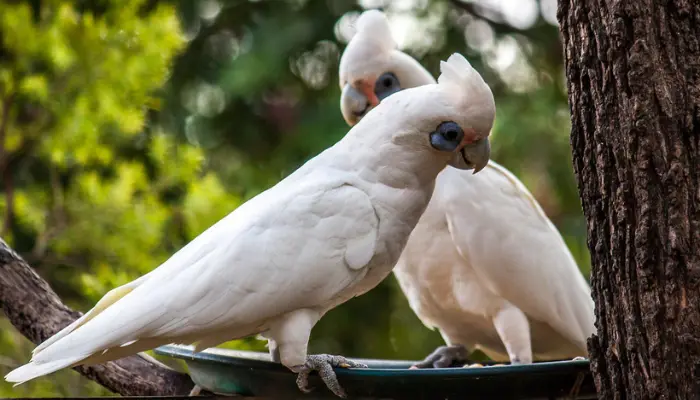The Bare-eyed Cockatoo also known as the Little Corella which is a charming and charismatic parrot species native to Australia. With its distinctive white plumage, delicate peachy-pink crest, and striking blue eye-ring, this avian beauty captures the hearts of bird enthusiasts worldwide. Beyond its captivating appearance, the Bare-eyed Cockatoo possesses a playful and intelligent nature, making it a delightful companion for those willing to provide the attention and care it deserves.
In this introductory exploration, we delve into the fascinating world of the Bare-eyed Cockatoo, uncovering its unique characteristics, habitat, behavior, and the joys of sharing your life with one of these enchanting creatures.
Origin and History of Bare-Eyed Cockatoo
The bare-eyed cockatoo is a cool bird from northern Australia. This bird was discovered by a scientist named John Gould in 1843. These birds have bare patches of blue-gray skin around their eyes and pinkish-white feathers. They like hanging out in small groups and are pretty noisy. While they are not in danger of disappearing, they face problems like losing their homes to people cutting down trees and being captured for the pet trade. Some folks like having them as pets because they’re fun and look neat, but it’s important to take good care of them.

Scientific Classification of Bare-Eyed Cockatoo
The scientific classification of the Bare-eyed Cockatoo also known as Little Corella, is as follows.
| Kingdom | Animalia |
| Class | Aves (Birds) |
| Family | Cacatuidae |
| Scientific Name | Cacatua sanguinea |
| Common Name | Bare-eyed Cockatoo or Little Corella |
| Bird Size | The Bare-eyed Cockatoo is a medium-sized cockatoo, typically measuring around 35 to 40 centimeters (14 to 16 inches) in length. |
| Feather Color | The plumage of the Bare-eyed Cockatoo is mostly white with pinkish patches on the face, throat, and belly. They have blue skin around the eyes, giving them their distinctive “bare-eyed” appearance. |
| Crest Color | The crest of the Bare-eyed Cockatoo is usually yellowish-white. |
| Lifespan | Bare-eyed Cockatoos have a relatively long lifespan, often living between 40 to 60 years in captivity with proper care. |
| Price Range | Prices for Bare-eyed Cockatoos can vary depending on factors such as age, temperament, and whether they are hand-reared or parent-raised. Typically, prices range from a few hundred dollars to around $2000. |
The Bare-eyed Cockatoo, scientifically known as Cacatua sanguinea, is a medium-sized bird with predominantly white plumage and distinctive pinkish patches on its face and belly.
Bare-Eyed (Little Corella) Cockatoo Colors and Marking
Where to Buy a Cockatoo
Here are two methods for purchasing a bare-eyed cockatoo, one online and one through a physical shop.



